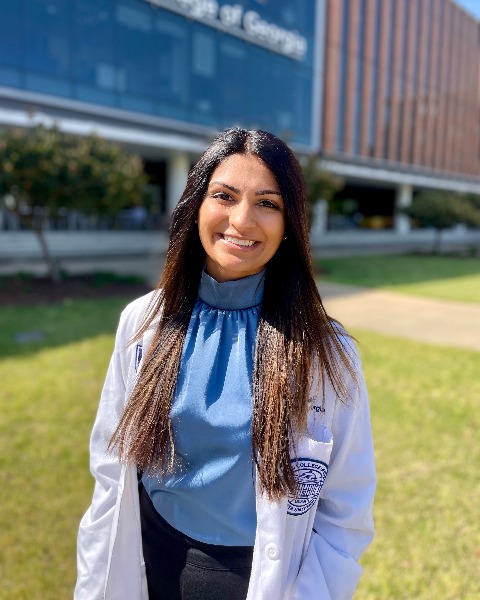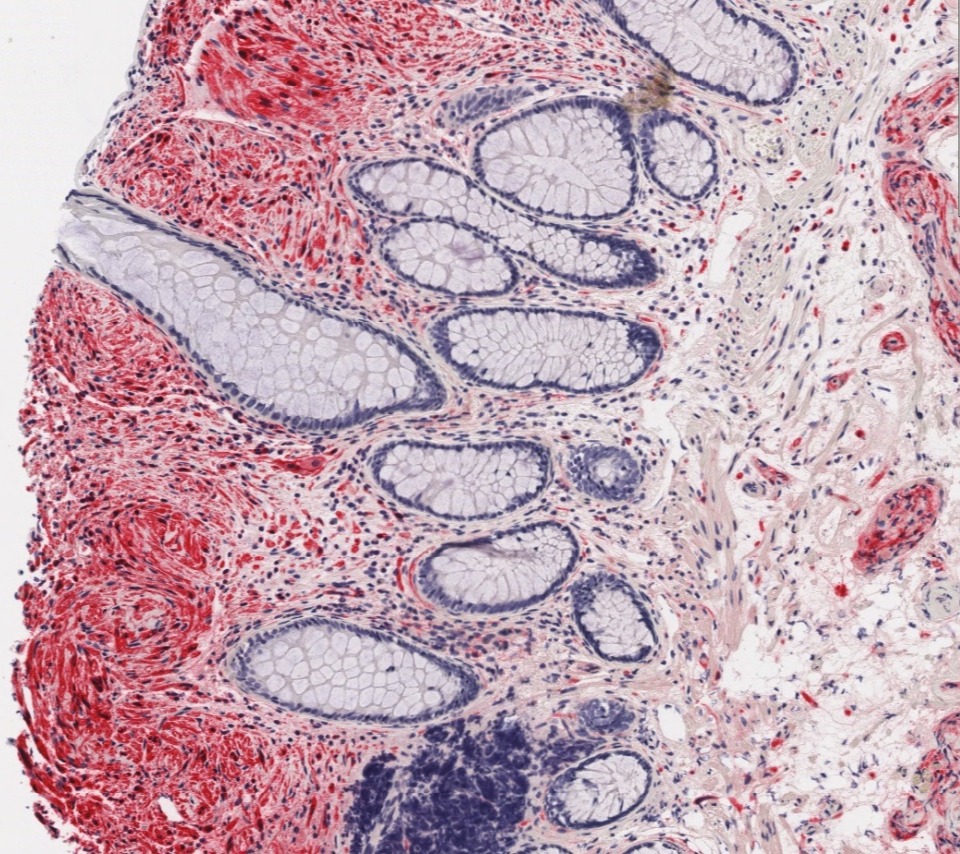Back
Poster Session A - Sunday Afternoon
A0277 - COWden Syndrome: A Rare Spotting
Sunday, October 23, 2022
5:00 PM – 7:00 PM ET
Location: Crown Ballroom

Nimisha Vasandani
Medical College of Georgia
Augusta, GA
Presenting Author(s)
Nimisha Vasandani, 1, Ahmad Alkaddour, MD1, Pooja Mude, DO2, Subbaramiah Sridhar, MBBS, MPH1, John Erikson L. Yap, MD2
1Medical College of Georgia, Augusta, GA; 2Augusta University Medical College of Georiga, Augusta, GA
Introduction: Cowden syndrome (CS) is a rare autosomal dominant disorder characterized by multiple hamartomas in any organ throughout the body. Patients with CS are at an increased risk of developing various other cancers. Below, we describe a unique case of diffuse ganglioneuromas found in the duodenum of a patient with a PTEN mutation and established diagnosis of CS.
Case Description/Methods: A 40-year-old man was referred to the gastroenterology clinic for upper endoscopy and colonoscopy after recently being diagnosed with CS based on the PTEN gene mutation. Physical exam findings were significant for frontal macrocephaly and hyper-extendable joints. Laboratory markers were unremarkable. Colonoscopy revealed multiple small and large polyps; upper endoscopy showed numerous gastroduodenal polyps, which were removed.Polypoid-appearing duodenal mucosa was biopsied and pathology findings confirmed ganglioneuroma via positive S-100 stain.
Discussion: The mutated PTEN gene is responsible for the multiple hamartomas and possible neoplasm formation seen in CS. Classic manifestations of CS include variable expression of dermatologic manifestations. These include: oral papillomas, trichilemmomas on the face, sclerotic fibromas of the skin (found in 90% of patients). GI involvement of CS may include asymptomatic hamartomas, lipomas, and adenoma polyps (found in 80% of patients).
GI ganglioneuromas are rare, well-differentiated benign tumors of the enteric nervous system that are predominantly found in the colon. Not commonly found, GI ganglioneuromas have been associated with CS and can remain asymptomatic until growing large enough to produce a mass effect. This cancause GI bleeding secondary to ulceration of the mucosa. Thus, when found, it is crucial these tumors are resected for excellent prognosis.
Duodenal ganglioneuromas are very uncommon and there has been no previously reported association of them with CS. Limited case reports are available on duodenal ganglioneuromas, however, one case described treating the tumor similarly to other GI ganglioneuromas.This proved surgical resection is successful in eliminating recurrence of the tumor based on surveillance with monthly stool occult blood tests in the first year after diagnosis?, followed by annual endoscopies.
In conclusion, the discovery of intestinal ganglioneuromas should make clinicians consider PTEN genetic testing. Endoscopists should consider performing random duodenal biopsies for patients with established Cowden’s syndrome.

Disclosures:
Nimisha Vasandani, 1, Ahmad Alkaddour, MD1, Pooja Mude, DO2, Subbaramiah Sridhar, MBBS, MPH1, John Erikson L. Yap, MD2. A0277 - COWden Syndrome: A Rare Spotting, ACG 2022 Annual Scientific Meeting Abstracts. Charlotte, NC: American College of Gastroenterology.
1Medical College of Georgia, Augusta, GA; 2Augusta University Medical College of Georiga, Augusta, GA
Introduction: Cowden syndrome (CS) is a rare autosomal dominant disorder characterized by multiple hamartomas in any organ throughout the body. Patients with CS are at an increased risk of developing various other cancers. Below, we describe a unique case of diffuse ganglioneuromas found in the duodenum of a patient with a PTEN mutation and established diagnosis of CS.
Case Description/Methods: A 40-year-old man was referred to the gastroenterology clinic for upper endoscopy and colonoscopy after recently being diagnosed with CS based on the PTEN gene mutation. Physical exam findings were significant for frontal macrocephaly and hyper-extendable joints. Laboratory markers were unremarkable. Colonoscopy revealed multiple small and large polyps; upper endoscopy showed numerous gastroduodenal polyps, which were removed.Polypoid-appearing duodenal mucosa was biopsied and pathology findings confirmed ganglioneuroma via positive S-100 stain.
Discussion: The mutated PTEN gene is responsible for the multiple hamartomas and possible neoplasm formation seen in CS. Classic manifestations of CS include variable expression of dermatologic manifestations. These include: oral papillomas, trichilemmomas on the face, sclerotic fibromas of the skin (found in 90% of patients). GI involvement of CS may include asymptomatic hamartomas, lipomas, and adenoma polyps (found in 80% of patients).
GI ganglioneuromas are rare, well-differentiated benign tumors of the enteric nervous system that are predominantly found in the colon. Not commonly found, GI ganglioneuromas have been associated with CS and can remain asymptomatic until growing large enough to produce a mass effect. This cancause GI bleeding secondary to ulceration of the mucosa. Thus, when found, it is crucial these tumors are resected for excellent prognosis.
Duodenal ganglioneuromas are very uncommon and there has been no previously reported association of them with CS. Limited case reports are available on duodenal ganglioneuromas, however, one case described treating the tumor similarly to other GI ganglioneuromas.This proved surgical resection is successful in eliminating recurrence of the tumor based on surveillance with monthly stool occult blood tests in the first year after diagnosis?, followed by annual endoscopies.
In conclusion, the discovery of intestinal ganglioneuromas should make clinicians consider PTEN genetic testing. Endoscopists should consider performing random duodenal biopsies for patients with established Cowden’s syndrome.

Figure: Histological Slide: S-100 immunohistochemistry of the duodenal polyp showing expansion of the lamina propria with the presence of diffusely positively stained ganglioneuronal cells.
Disclosures:
Nimisha Vasandani indicated no relevant financial relationships.
Ahmad Alkaddour indicated no relevant financial relationships.
Pooja Mude indicated no relevant financial relationships.
Subbaramiah Sridhar indicated no relevant financial relationships.
John Erikson Yap indicated no relevant financial relationships.
Nimisha Vasandani, 1, Ahmad Alkaddour, MD1, Pooja Mude, DO2, Subbaramiah Sridhar, MBBS, MPH1, John Erikson L. Yap, MD2. A0277 - COWden Syndrome: A Rare Spotting, ACG 2022 Annual Scientific Meeting Abstracts. Charlotte, NC: American College of Gastroenterology.
